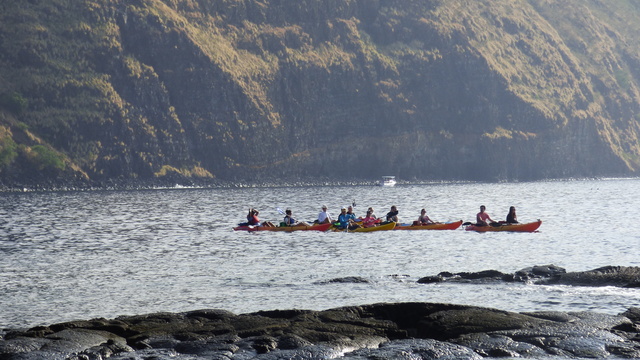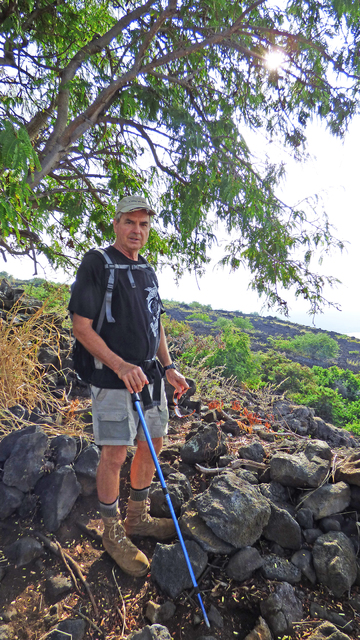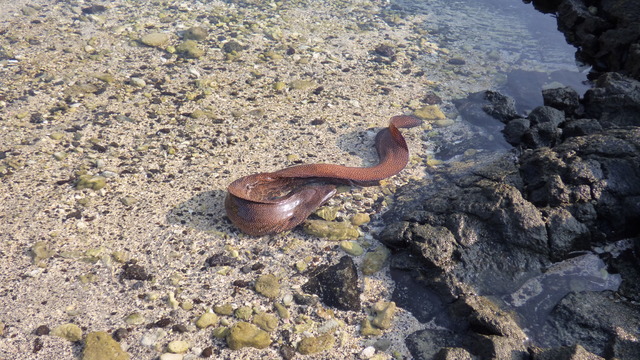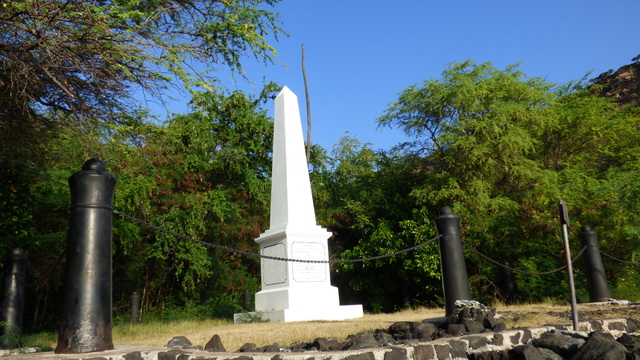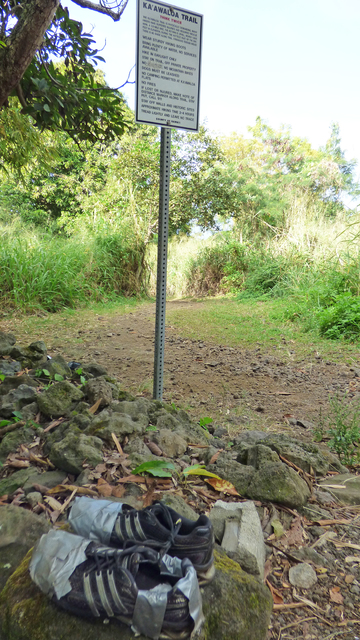South Kona’s popular Kaawaloa Trail historic, challenging, rewarding
CAPTAIN COOK — The Kaawaloa Trail is seducing, with its constant downward course and its warm beauty and history at the trail’s end.
But going back up, hikers are reminded that only fools think such things are free.
Start this 4-mile roundtrip trek from the Napoopoo junction to the Captain Cook Monument at the edge of Kealakekua Bay in the early morning and you can escape some of the punishment. Tackle the steep, ancient Hawaiian pathway in the middle of the day without water, however, and you’re asking for trouble.
Especially in the summer.
Bruce Cherry, a sort of unofficial “trail doc,” sees examples of this all the time.
Cherry, 67, is a retired Kailua-Kona school teacher and former pilot. Twice a week he can be found on what is often called the Captain Cook Monument Trail, where he trains both his body and his attitude.
“I spend a lot of time hiking on the mainland — Alaska, Montana,” he said. “This is a really good fitness trail. It kicks your butt, but if you do it often enough, you develop a lot of mental stamina.”
On Saturday, Cherry accompanied me on a portion of the 1,300-foot drop to the sea. As he passed other hikers — who greeted him with accents from all over the world — Cherry’s eyes flicked instinctively to their backpacks and water bottles. He was trying to size up who was properly prepared, and who might need his help later on.
“I bring a lot of extra water. I bring about four liters, because I have to give away three,” said Cherry, who hikes with a pole in one hand and a handkerchief which he calls his sweat rag, in the other.
It takes him about 53 minutes going down and 50 minutes to come back up. That’s because the trail’s loose stones are trickier to navigate on the descent. But Cherry recommends the inexperienced hiker allow at least an hour both ways. A cautionary sign warning hikers to “think twice” before tackling the route says two to four hours should be set aside to complete the hike.
Cherry passed several groups moseying down the slope toward the bay. Many weren’t sure exactly what they’d find, and asked questions. Several were equipped with nothing but their shoes, shorts, shirts and optimism. Cherry shook his head.
“I see people dressed in slippers,” he said. “Some of the women are in bikinis. I meet them halfway back up and they’re in a sad state of affairs. I have to sit with some of them and give them the electrolytes I carry and some of my water. I can’t tell you how many people I’ve met just lying on the trail.
“It’s cool right now, but if you hike this in July, it’s a beast.”
And as the sun climbed toward 10 a.m. on the exposed trail, the sweat began to flow like water.
“Got enough water?” Cherry kept quizzing hikers he met.
Some of the visitors had small children, and chances were good they would turn back soon. Others would press on and take the punishment of mid-day heat and humidity.
A few were well equipped. Like Julien Archambeault of Quebec, who tackled the trail to take advantage of the incredible snorkeling at the bay, and because he’s heard the water — surrounded to the north by high cliffs and rimmed to the west with Captain Cook’s resting place and remnants of historic villages — is a haven for dolphins.
He’s right, of course. Moray eels like the bay too.
“I don’t think people come for the trail,” Archambeault said, pausing near one of the historic stone walls that crisscross the shoreline areas. “They come for the monument and the snorkeling.”
At the bottom of the Kaalaloa Trail, a left fork led to the Captain Cook Monument, erected in 1874 to honor the fallen explorer who died near here in 1779 in a dispute with villagers. Visitors milled around the large white obelisk and slipped into the water to snorkel the famously abundant coral reefs. A faint side trail also took off to the south, through haole koa and large acacia trees, to a pocket beach fronting a tidepool.
That’s where the three-foot-long moray eel lives.
I noticed him first with a shock near my feet as I waded the pool. The eel was casually poking its face into cracks in the rock just at the water’s surface, prompting me to scramble onto dry land. At one point, the eel lunged for a black shore crab, literally coming out of the water to snap at the fleeing creature, but the crab escaped across the rocks.
I followed the eel as it hunted, writhing its brown, white-specked body through the cracks in the lava shore. It seemed completely unafraid — perhaps just the opposite — and several times stuck its head and open white mouth out of the water when it was nearest to me. I allowed the creature to make its way to the other end of the pool before I got back in the water.
What hike would be complete without a dip?
I never stopped thinking about the eel, though, and kept a wary eye on a shallow area that separated it from me. Rising up to look after only a few moments suspended in the water, I noticed the eel coming back over the shallow spot, heading straight for me. I climbed quickly out of the water and watched as the eel took over the area where I had been swimming just seconds before.
No question which one of us belonged there. It was time to take a long drink from the canteen and hike back.
The real challenge lay ahead.


